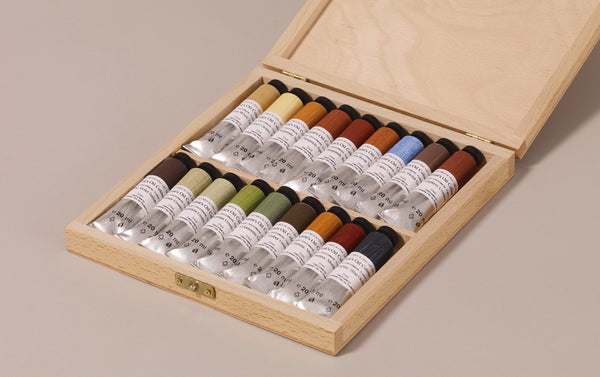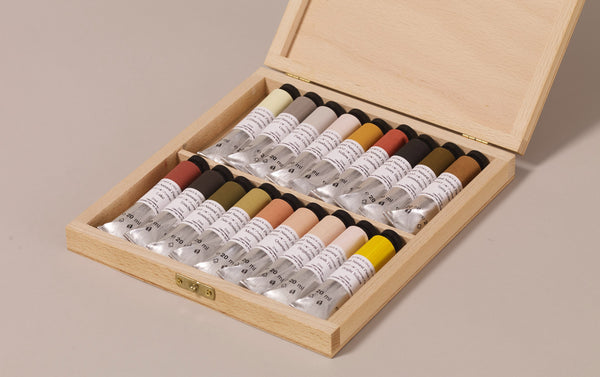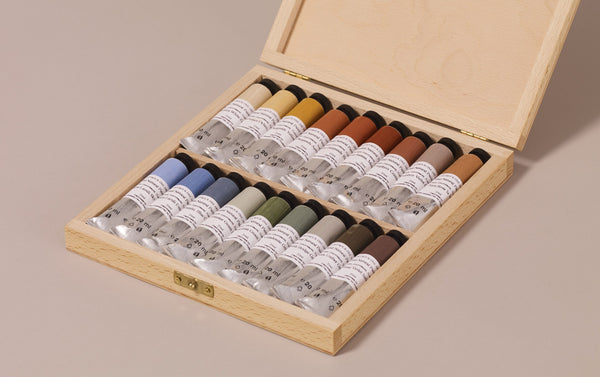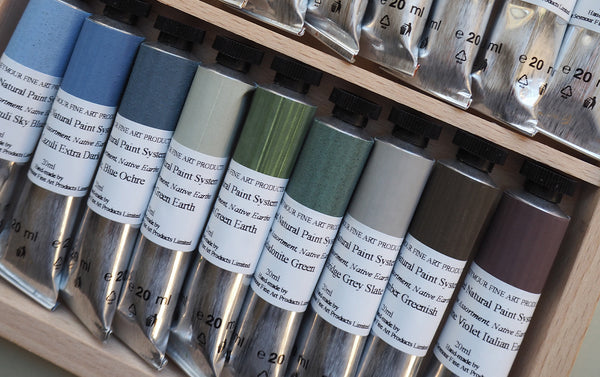Natural Pigment Oil Botanical Set
£425.00
From the studio of our most respected pigment experts, Pip Seymour and Rebecca Wallace, we are pleased to offer this professional grade oil paint box. In the face of declining quality due to mass manufacturing, as artists themselves, they began making paints to their own tastes and recipes looking to emulate art materials from the past, with more individuality and natural appearance.
These are formulated using 100% natural pigments sourced from sustainable materials from either rocks, mineral and earth deposits - milled in cold pressed linseed oil from a single farm estate in England. Cold pressed (as opposed to refined) linseed oil is a premium material used only by the best art material companies for its clarity and ability to realise bright colour resonance. Once dried linseed oil also affords a long-lasting hard and durable gloss effect (preferable to matte finishes which attract dust and dirt)
The pigments selected for this 18 tube assortment have been designed with botanical painting specifically in mind.
Details:
Material: 18 x Oil Paint 20ml tubes
Lightfastness: Permanent once dried.
Included: A wooden presentation box
Vegetarian: No (contains pigment derived from crushed cochineal beetles)
Vegan: No (contains pigment derived from crushed cochineal beetles)
Pigments:
Weld - a light, lemon yellow which is hand processed from the reseda luteloa plant, commonly known as 'dyer's rocket' for its use in the production of weld which is a natural dye thought to have been used since the first millennium BC.
Stil de Grain - formerly known as 'pinke', this transparent yellow is rich and warm. Made from buckhorn berries which are processed by hand, it is rare to find this natural pigment (which is not out of place on medieval illuminated manuscripts) in modern paint recipes.
Gamboge - This is a resin that is extracted from the Garcinia tree which is native to India and South East Asia. It is a mustard yellow that has been used to dye monks robes in Buddhist tradition.
Orange Madder - This pigment is made from the roots of the madder plant and it is one of the most stable natural pigments. The madder used by Wallace Seymour is from artisanal crop cultivation and traditional, organic harvest and processing methods.
Madder Lake - madder is a pigment that has around since antiquity - It can be found in ancient Egyptian artwork - commonly found in mummy portraits and cloth dyed with Madder was even found in the tomb of Tutankhamun.
Carmine - this pigment is derived from the cochineal beetle which is native to South America. First used by the Aztecs and brought to Europe in the sixteenth century it is a rich, deep red.
Cochineal Munich Lake - a pinker tone to the above; again derived from the cochineal beetle, all of which are farmed for purpose in these natural pigments.
Carmine Red - this lighter red tone includes natural ochre alongside the carmine. Ochre is a natural clay pigment which is mined from a working quarry and has been around since antiquity.
Carmine Purple - this deep red-purple is a mixture of carmine and indigo which is a pigment commonly used in textiles (best known as the pigment used to dye blue jeans!).
Maya Green - This deep teal is named after the Maya people of ancient Mesoamerica as this colour was found used in many of their wall paintings, this particular shade is derived from indigo which is sourced by Wallace Seymour from India using traditional methods.
Kendal Green - A mixture of indigo and weld is used to create this grassy green; named after the Lancaster town of Kendal which was once a market town known for its export of woollen goods, and in particular a hard wearing wool based fabric of this colour (known as Kendal Green!).
Vert Cambodge - Translating into English to mean ‘Green Cambodia’, this rich green is made up from gamboge and spirulina blue.
Indigo - Commonly used in textiles it is also known as woad in European production, true indigo however is the pigment derived from the leaves of the Indigofera tinctoria plant (woad is made from Isatis tinctoria - of the same family)
Spirulina Blue - Made from spirulina, a blue-green algae that is also used as a dietary supplement and has been consumed by humans since the Aztecs! It is a bright, royal blue.
Maya Blue - This is a specialist form of Indigo wherein a fibrous clay and magnesium silicate are mixed with the blue pigment; Indigo is known to fade in sunlight but with these additions the colour is preserved for longer.
Walnut Marron - A light brown which is harvested from artisanal crop cultivation; no chemicals are used and it is foraged in small batches, using traditional techniques.
Whitby Jet - A brown-black with good granulation and texture, this black is derived from fossilised plant material; more specifically ‘jet’ refers to a mineraloid which is fundamentally wood that has been changed under extreme pressure.
Vine Black - Pure carbon pigment made from charred vines.




